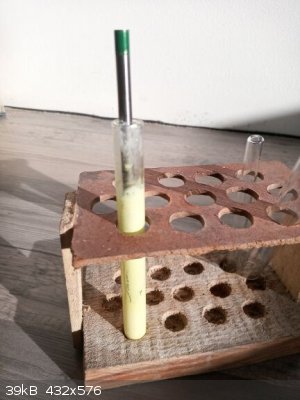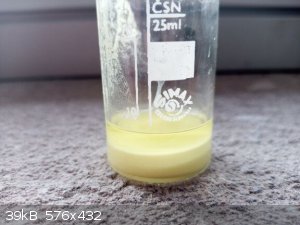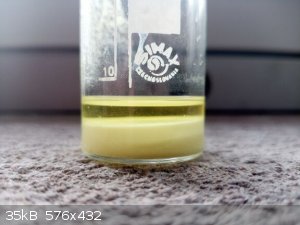Fery
National Hazard
   
Posts: 990
Registered: 27-8-2019
Location: Czechoslovakia
Member Is Offline
|
|
dissolving W in H2O2
Here my experiment - dissolving tungsten in hydrogen peroxide. Unfortunately there is no info about stabiliser in H2O2 but there must be some as the
bottle is 15 years old, the concentration at the bottle label is 30% and analyzing it (volumetric) the concentration still exceeds 30% (while my other
only 3 years old pharma grade 3% H2O2 bottle contains almost no H2O2 - I believe that pharma is unstabilized H2O2).
To the testing tube 5 ml of 30% H2O2 (0,0500 mol) was poured, then tungsten (99,8%) welding electrode (TIG) inserted and was let to react at room
temperature for 3 weeks. Peroxotungstic acid is better soluble in water than tungstic acid so at the end of reaction when H2O2 was consumed up the
H2WO4 started to precipitate.
The electrode was removed from the testing tube while spattering it with H2O using a syringe and dried out. The testing tube content was mixed well
and quickly transferred into 25 ml beaker (the product has quite high density and settles readily), testing tube flushed with few ml of water, which
was added into the beaker and the product in the beaker was let to dry out at room temperature for few weeks.
The electrode weighed 107,4 g initially and 105,1 g finally.
2,3 g of W dissolved, molar mass 183,95 g/mol which means 0,0125 mol. So most of H2O2 reacted (0,0375 mol) and only little of it decomposed (0,0125
mol) - there is still some pertungstic acid present so the amount of decomposed H2O2 is even less than that 0,0125 mol.
W + 3 H2O2 -> H2WO4 + 2 H2O
the reaction after 3 weeks at room temperature (for first weeks it was only boring very pale yellow clear solution)

drying out the product at room temperature
 
|
|
|
rockyit98
Hazard to Others
  
Posts: 283
Registered: 12-4-2019
Location: The Known Universe
Member Is Offline
Mood: no mood is a good mood
|
|
NileRed did this in "Making a Nylon Precursor using Green Chemistry"
https://www.youtube.com/watch?v=O0LqwYTSir4
"A mind is a terrible thing to lose"-Meisner
|
|
|
sbreheny
Hazard to Others
  
Posts: 145
Registered: 30-1-2014
Member Is Offline
Mood: No Mood
|
|
Very nice! Is your welding electrode Thoriated? Just a bit of caution in case it is because you will end up with a slightly radioactive water soluble
material which requires some care to avoid ingesting any of it, even a tiny bit (it wouldn't be "the end of the world" but it is best to avoid it)
[Edited on 17-2-2020 by sbreheny]
|
|
|
Fery
National Hazard
   
Posts: 990
Registered: 27-8-2019
Location: Czechoslovakia
Member Is Offline
|
|
Hi sbreheny, this is without thorium, the green color means pure 99,8% W.
I have also about half a kilo of thoriated electrodes in stock (96% W + 4% ThO2).
I consulted the Th problem with my collegue working in nuclear medicine and he wrote me that it would require centuries for Th to decay to dangerous
amounts of products - so I store them just laying in bubble foil as they were delivered to me from an eshop (sales out 50% prices, today everyone
poorly educated is scared so nobody buys them...). Toxicity of Th is much more important than radioactive decay products of fresh Th.
|
|
|